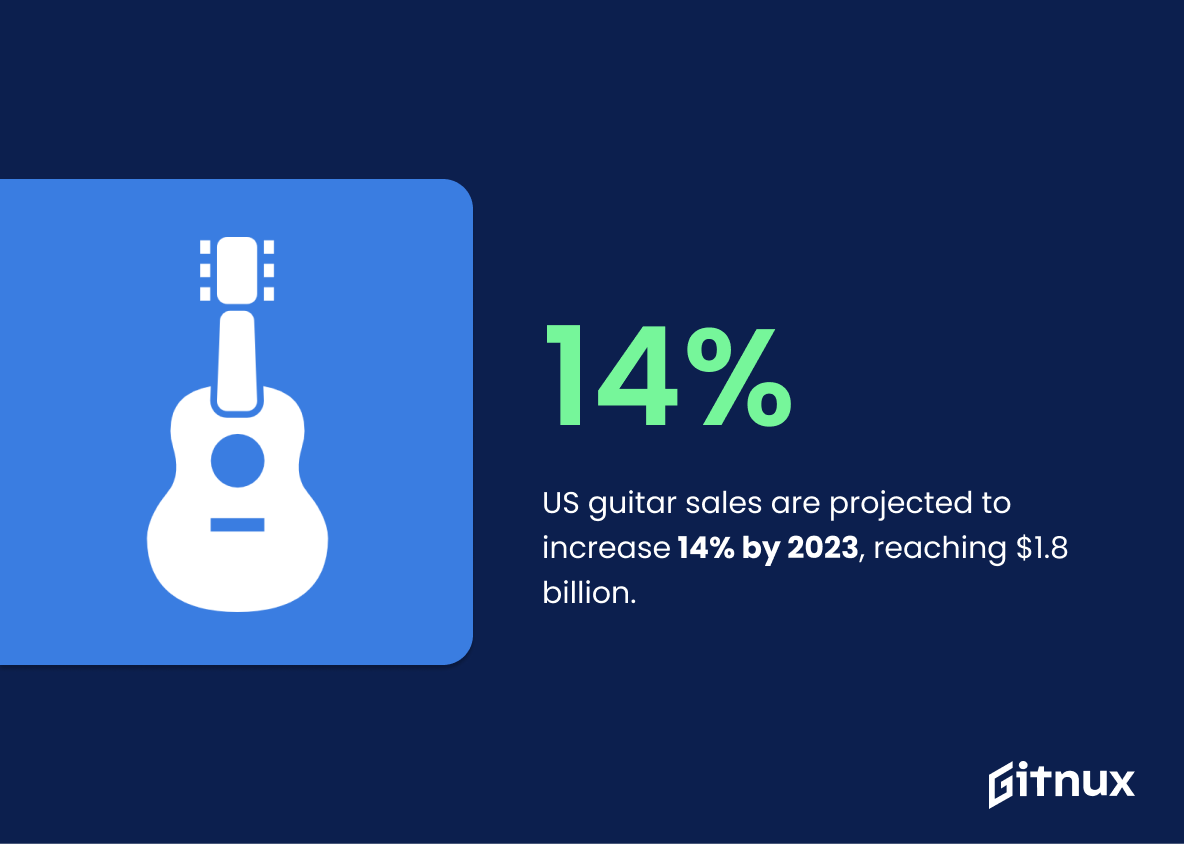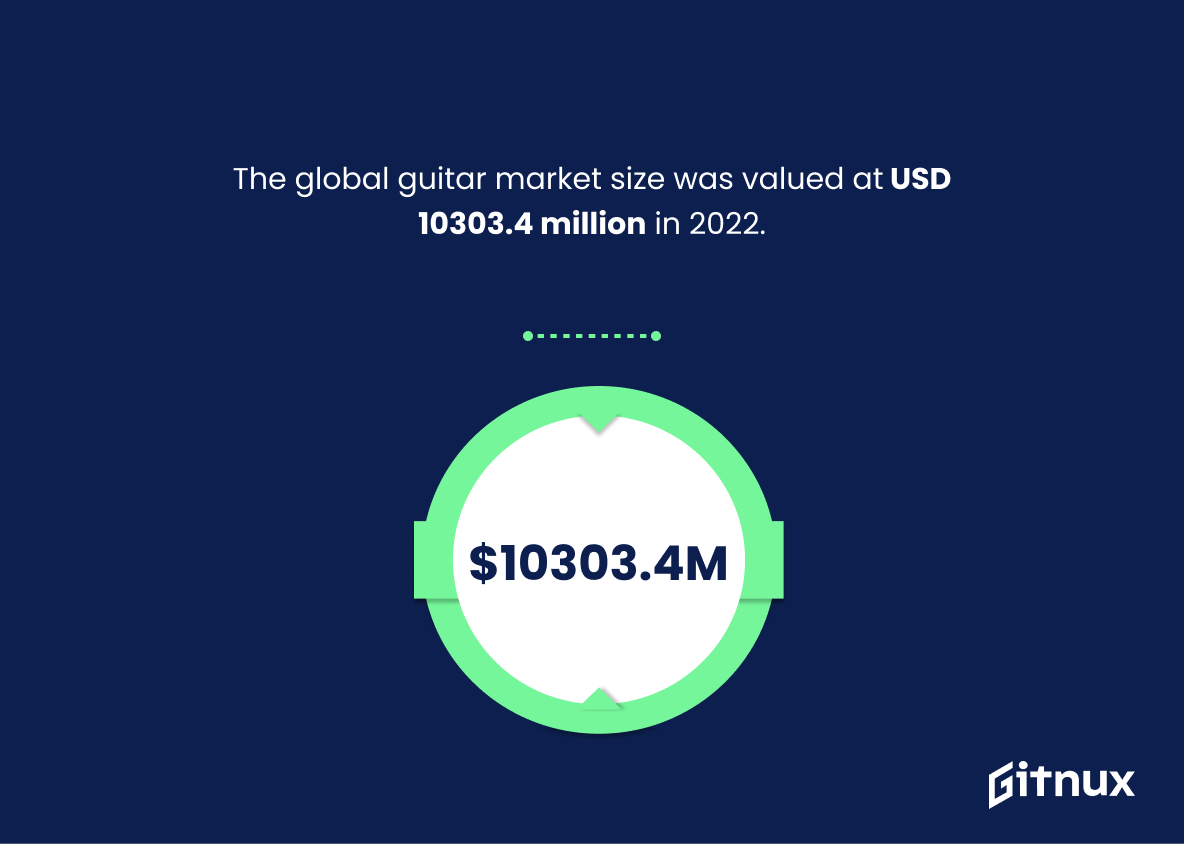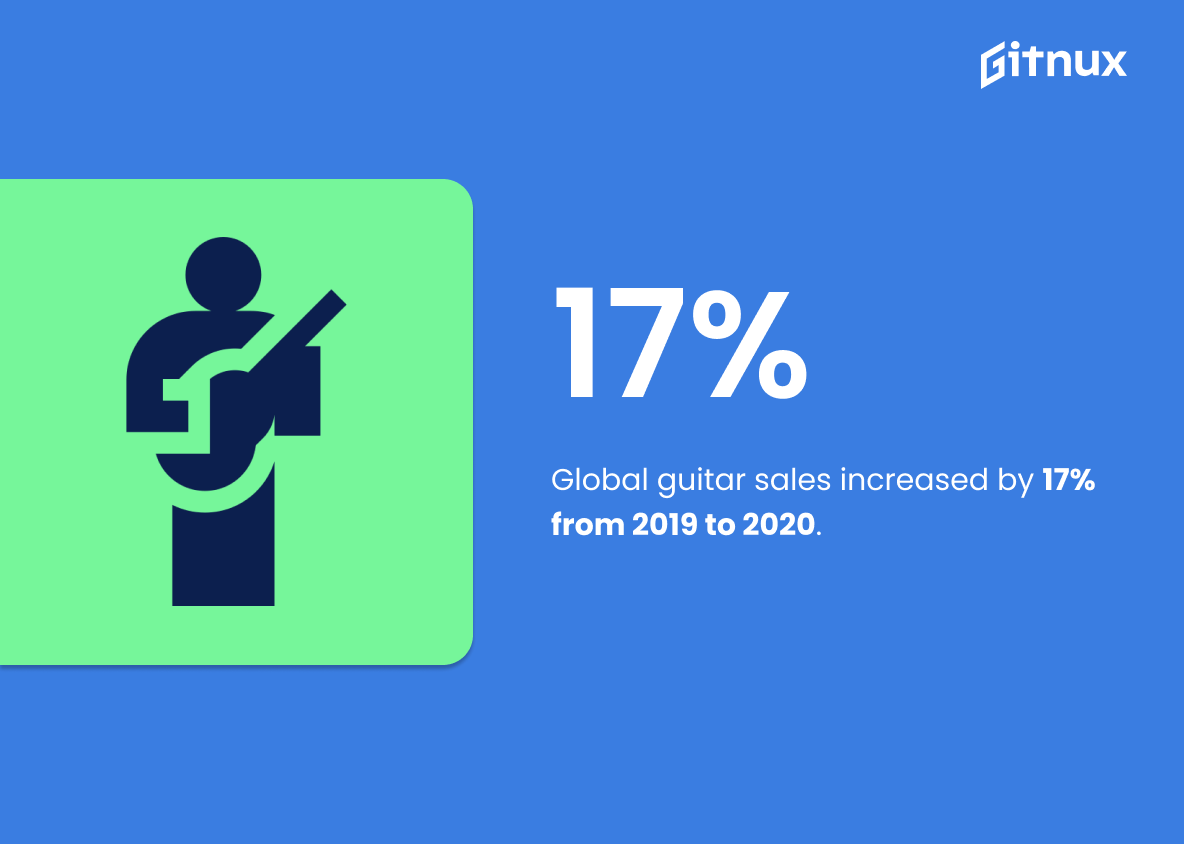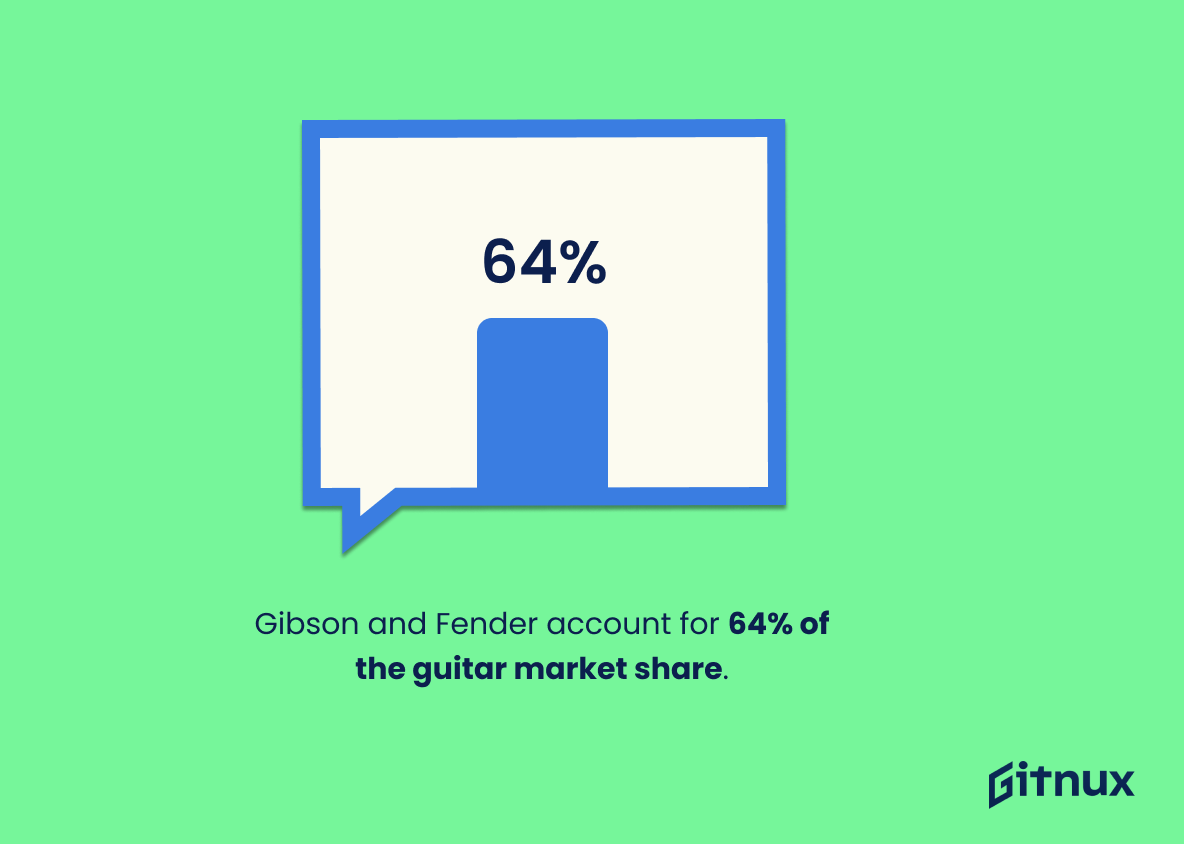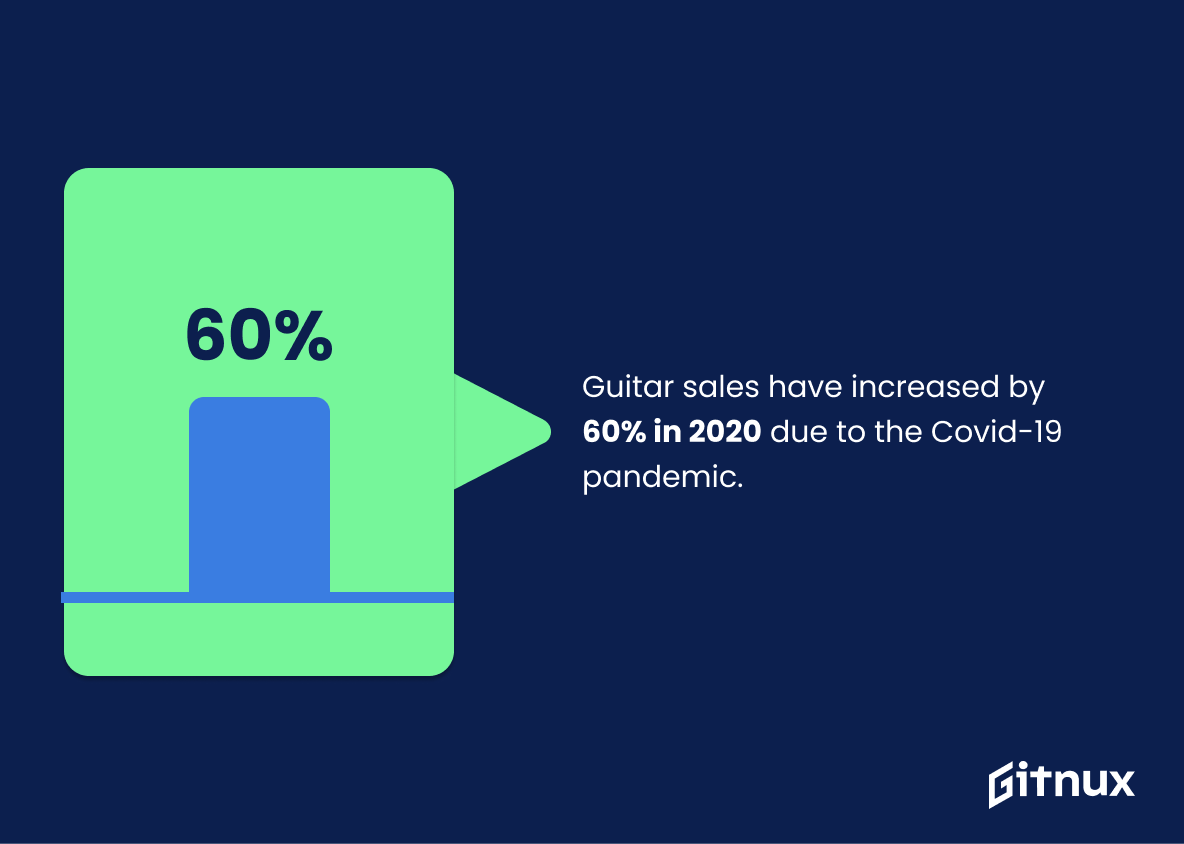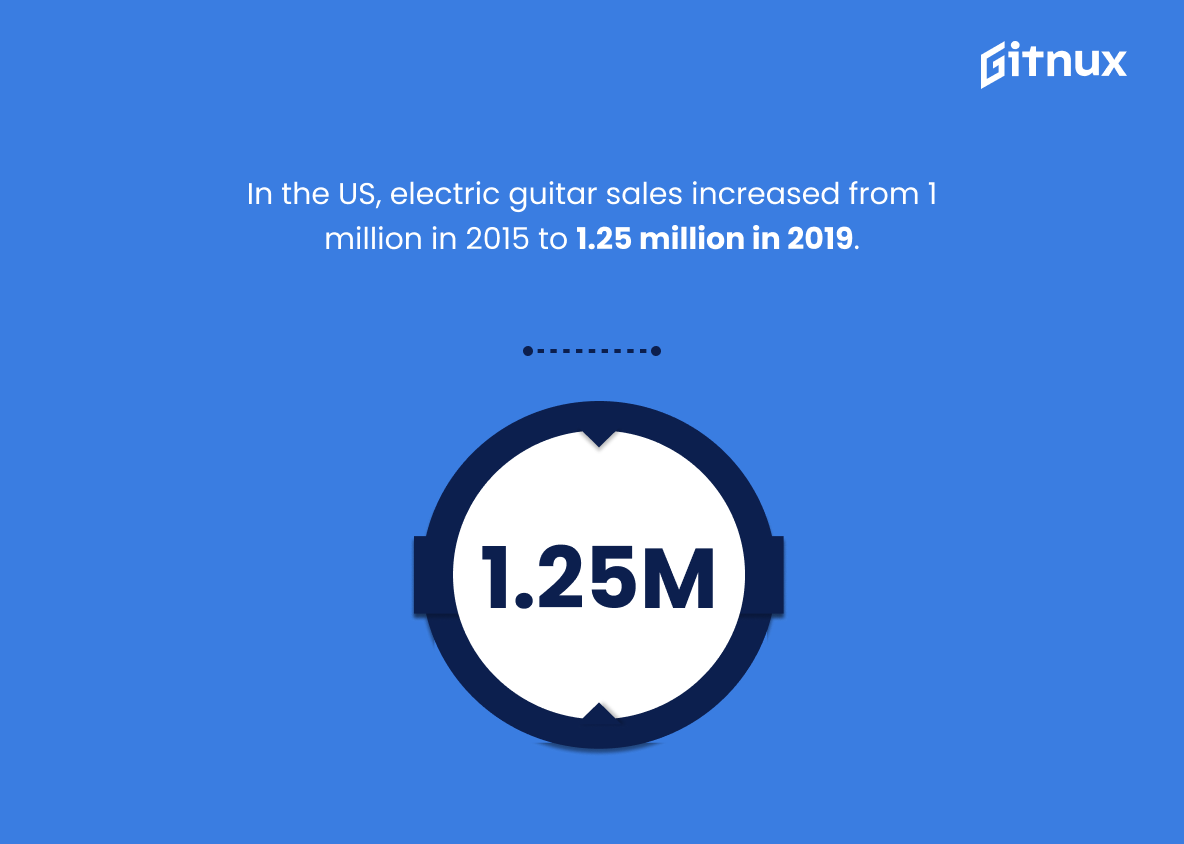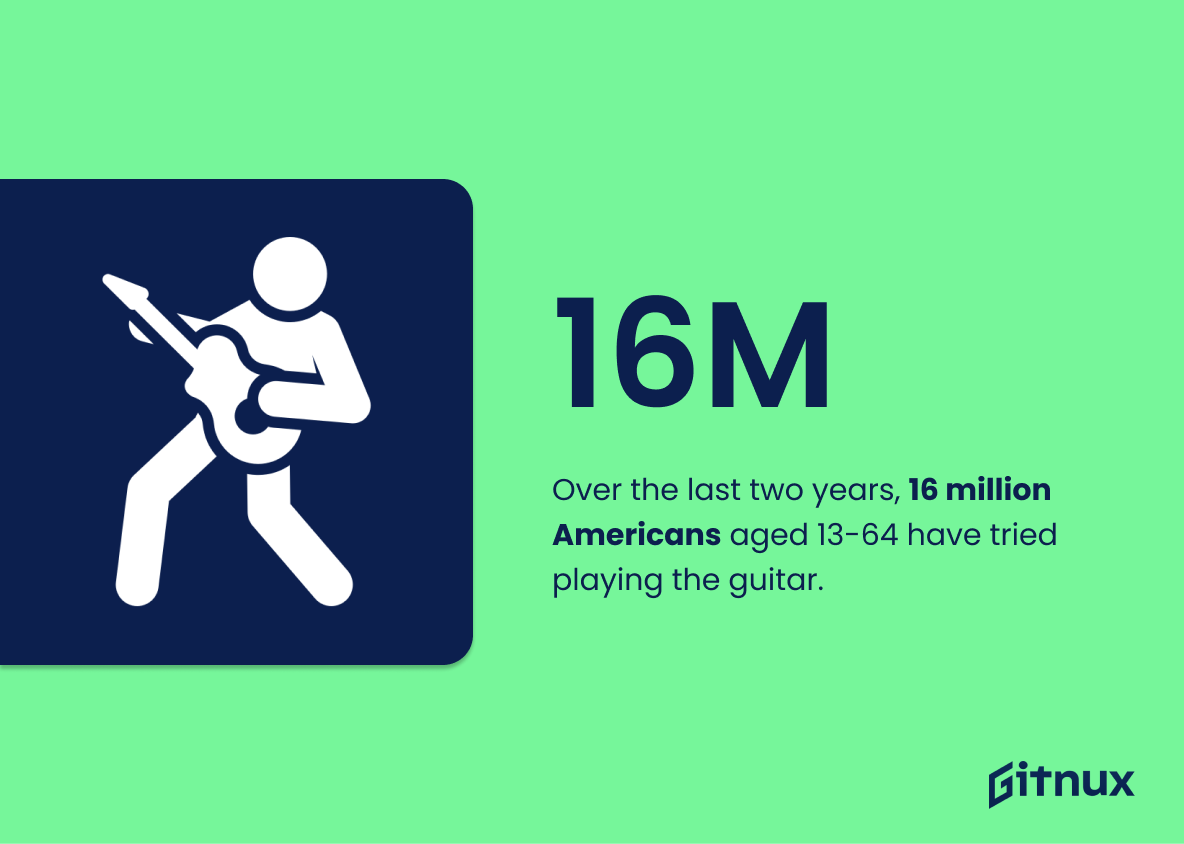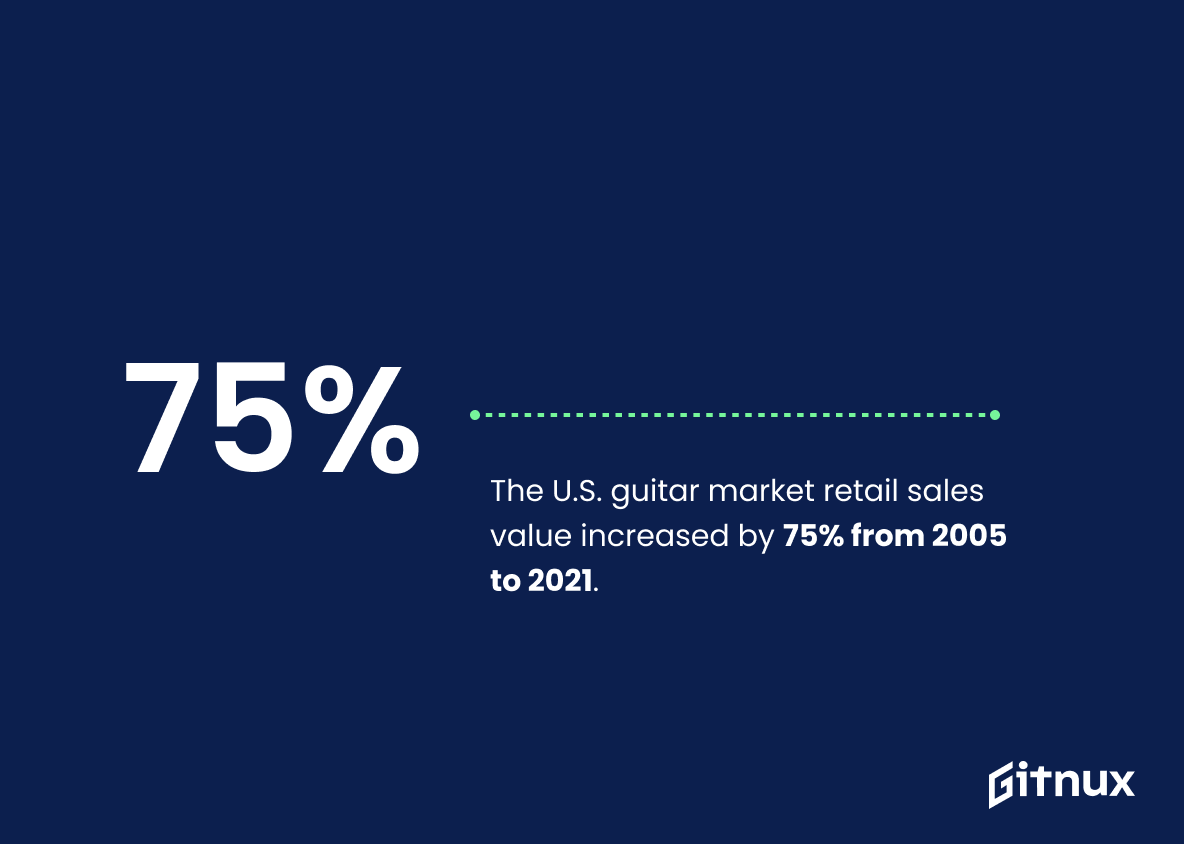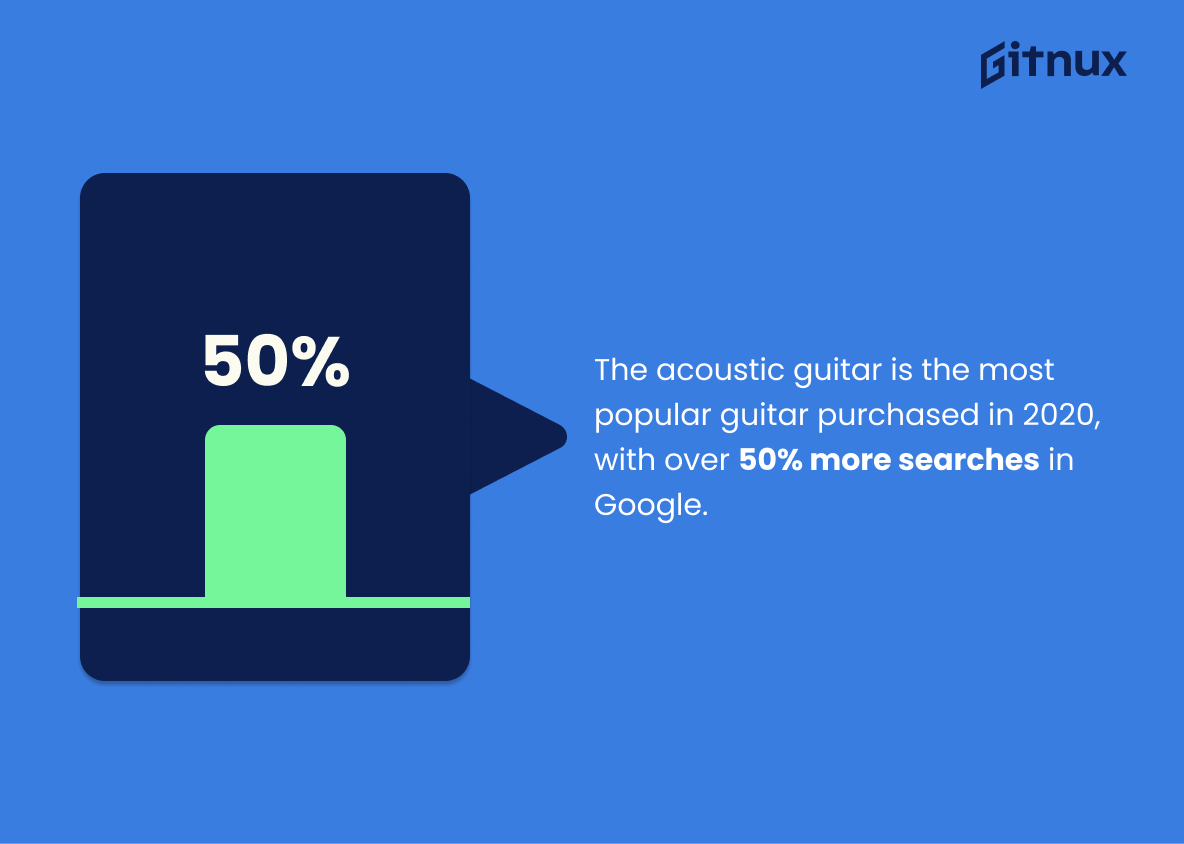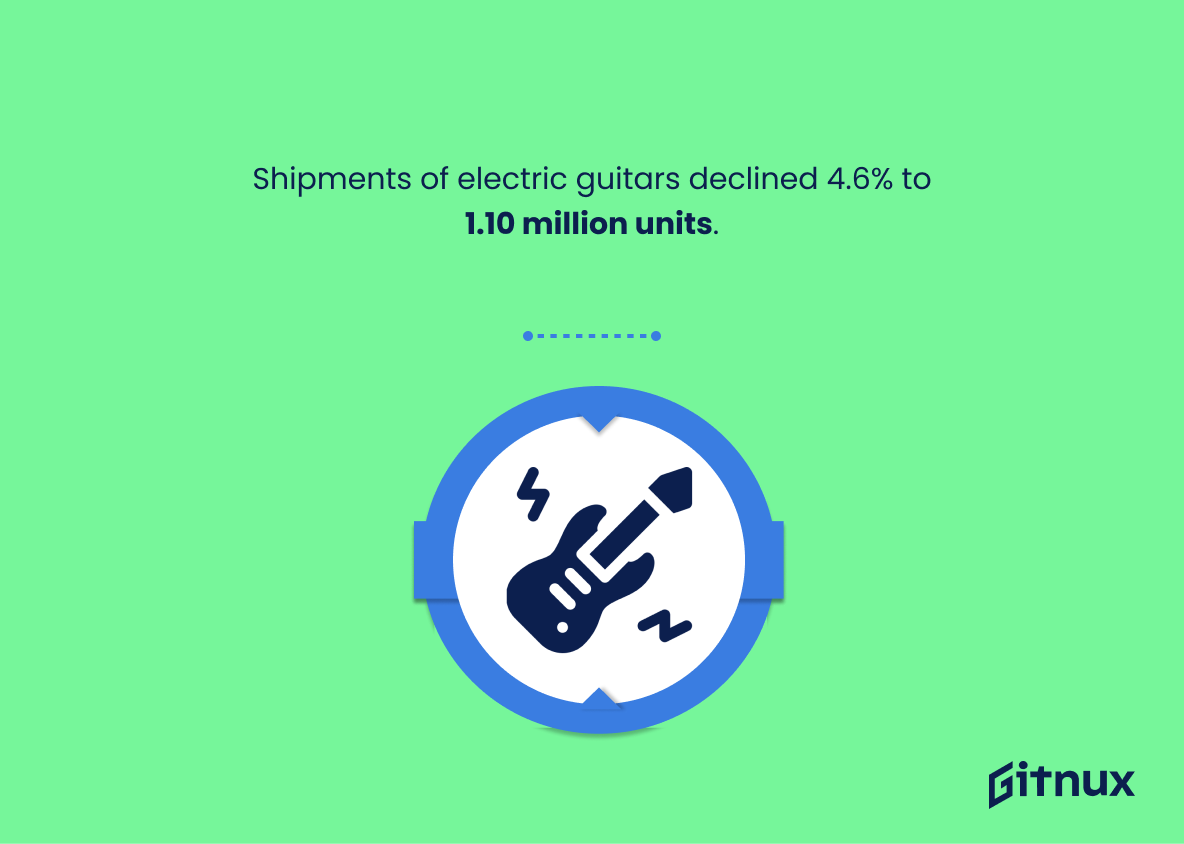Guitar players of all ages and skill levels have been captivated by the instrument for centuries. From the classic rock of the 70s to the modern metal of today, the guitar has been a staple of popular music for generations. But what does the data say about the guitar industry?
In this blog post, we’ll take a look at some of the most interesting guitar industry statistics and trends to give you a better understanding of the current state of the industry. We’ll also explore some potential implications of these statistics for the future of the guitar industry. So, if you’re a fan of the guitar, or just curious about the industry, read on to learn more.
Guitar Industry: The Most Important Statistics
The electric guitar market is projected to reach 645.3 million USD and grow at a 2.9% CAGR by 2028.
Gibson and Fender account for 64% of the guitar market share.
Guitar Industry: Statistics Overview
Guitar Sales Predicted Statistics
US guitar sales are projected to increase 14% by 2023, reaching $1.8 billion.
This statistic is important because it shows that the guitar industry is growing and that there is potential for further growth in the future. This could be a positive indicator for guitar manufacturers, retailers, and other businesses related to the guitar industry. Additionally, it could indicate that more people are becoming interested in playing guitar, which could lead to increased demand for guitar lessons, accessories, and other related services.
The acoustic guitar market is projected to grow at a CAGR of 5.8% from 2018-2028.
This statistic is important because it shows that the acoustic guitar market is expected to grow significantly over the next decade. This indicates that the guitar industry is likely to remain strong and profitable in the coming years, and that acoustic guitars will continue to be the dominant type of guitar in the market. This information can be used by guitar manufacturers, retailers, and investors to plan their strategies and make informed decisions.
50% of aspirational and beginner players are women.
This statistic is important as it shows that the guitar industry is becoming increasingly more inclusive to female players, which is a positive step towards creating a more diverse and equitable industry.
Guitar Market Size Statistics
The electric guitar market is projected to reach 645.3 million USD and grow at a 2.9% CAGR by 2028.
This statistic shows that the electric guitar market is growing steadily and is expected to continue to do so over the next few years. This is good news for the guitar industry, as it indicates that there is a strong demand for electric guitars and that the industry is likely to remain profitable in the near future.
The global guitar market size was valued at USD 10303.4 million in 2022.
This statistic highlights the size of the global guitar market and its growth potential. It also provides insight into the current state of the guitar industry, which can help inform business decisions and strategies. Additionally, it can be used to compare the guitar market to other industries and markets, giving a better understanding of the overall economic landscape.
Global guitar sales increased by 17% from 2019 to 2020.
This statistic matters because it shows that the guitar industry is continuing to grow, despite the economic downturn caused by the COVID-19 pandemic. This indicates that people are still interested in playing the guitar and that the industry is resilient. This could be a good sign for the future of the guitar industry.
Guitar Company Statistics
Gibson and Fender account for 64% of the guitar market share.
This statistic matters because it shows the dominance of Gibson and Fender in the guitar industry. It also shows that the other brands, such as Ibanez, Yamaha, and Epiphone, have much less of a market share, indicating that they are not as popular or successful as Gibson and Fender. This information can be used by guitar manufacturers to determine which brands to focus on and how to best market their products.
US and UK guitar brands both reported record sales in 2020, indicating a strong market for guitars.
In such manner, it highlights that the guitar industry is still thriving despite the pandemic, indicating that people are still interested in buying guitars and learning to play. This is a positive sign for the industry, as it suggests that the demand for guitars is still strong and that the industry is likely to continue to grow in the future.
Guitar sales have increased by 60% in 2020 due to the Covid-19 pandemic and are expected to reach $1.8 billion by 2023.
This matters in the context of Guitar Industry Statistics because it shows that the guitar industry is resilient and can still thrive despite difficult economic times. It also shows that the popularity of vintage instruments and the rise of online marketplaces like Reverb.com are driving the growth of the industry.
In the US, electric guitar sales increased from 1 million in 2015 to 1.25 million in 2019, but decreased by 9% in 2020 to 1.1 million.
In such manner, it shows the fluctuating popularity of electric guitars in the US market.
Over the last two years, 16 million Americans aged 13-64 have tried playing the guitar, with 62% citing the pandemic and lockdowns as their reasons.
This statistic is important for the guitar industry because it shows that the guitar market is expected to grow significantly over the next few years, likely due to the increased interest in playing the guitar during the pandemic. This indicates that the guitar industry will be able to capitalize on this growth, as more people are likely to purchase guitars and other musical instruments.
Guitar Market is valued at USD 1.36 Billion in 2021 and is expected to reach USD 2.02 Billion by 2028, with a CAGR of 5.80%.
This is important for the Guitar Industry as it shows that the market is growing and that the major players in the industry are investing in the market. This growth indicates a positive outlook for the industry and suggests that the industry will continue to be profitable in the future.
The U.S. guitar market retail sales value increased by 75% from 2005 to 2021, reaching a total of 2.02 billion U.S. dollars in 2021.
This statistic is important because it demonstrates the expansion of the guitar market in the United States over the past 16 years. It demonstrates that the guitar industry is growing and that the demand for guitars is increasing. This is important for the guitar industry as it indicates that the industry is healthy and that there is potential for further growth.
The acoustic guitar is the most popular guitar purchased in 2020, with over 50% more searches in Google, and electric guitars accounted for approximately 1.1 million of guitars sold in the US in year 2020.
The price difference between the two is not much, depending on the brand and model. This matters in the context of Guitar Industry Statistics because it shows that acoustic guitars are the most popular choice for guitar players, and that electric guitars are still a popular choice, but not as much as acoustic guitars.
Shipments of electric guitars declined 4.6% to 1.10 million units, while acoustic guitar sales increased to 1.2 million units, with a 34.7% market share.
This matters in the context of Guitar Industry Statistics because it shows that acoustic guitars are becoming more popular than electric guitars, and that electric guitars are losing market share. This could have implications for the future of the guitar industry, as companies may need to focus more on acoustic guitars in order to remain competitive.
The acoustic and electric guitar manufacturing industry in the US is estimated to be worth $713.1 million in 2022, with a slow market size growth of -0.1% in 2022 and 0.5% annualized growth from 2017-2022.
This statistic is important because it provides insight into the current and future size of the acoustic and electric guitar manufacturing industry in the US. It also reveals that the industry is growing slower than the overall economy, which could indicate that the industry is facing challenges and may need to adjust its strategies in order to remain competitive.
The Acoustic and Electric Guitar Manufacturing industry in the US has a market size of $714m, with Fender Musical Instruments Corp, Gibson Guitar Corp., C. F. Martin & Co., Inc. and Taylor Guitars being the four biggest companies in the industry.
This statistic matters in the context of Guitar Industry Statistics because it provides an indication of the size of the industry and the market share of the four biggest companies. It also provides an indication of the overall health of the industry.
Supplementary Statistics
The global guitar market is projected to reach $2.69 billion by 2027, with a CAGR of 3.4% during 2020-2027.
This is a positive sign for the industry, as it suggests that the guitar market is likely to remain strong and profitable in the years ahead. As such, this statistic is an important piece of information for anyone interested in the guitar industry and its future prospects.
The acoustic guitar segment accounted for 42.9% of the total guitar market share in 2019.
The acoustic guitar is the most sought-after type of guitar, accounting for almost half of the total guitar market share in 2019. This is a clear indication that the acoustic guitar is a major player in the guitar industry and should not be overlooked.
Over 2.6 million electric and acoustic guitars were sold in the United States in 2019.
Despite the ever-changing landscape of music and technology, the guitar remains a staple instrument in the music industry. This statistic is a reminder of the guitar’s importance and its continued relevance in the modern world.
41% of new electric guitar players are women.
The traditionally male-dominated field of electric guitar playing is becoming increasingly accessible to women, which is a positive sign for the industry as a whole. It also suggests that the industry is becoming more inclusive and welcoming to a wider range of players, which could lead to increased sales and more diverse music.
In 2018, 9.2 million people in the United States played the guitar.
Despite the ever-changing landscape of music, the guitar remains a beloved instrument for millions of people. This statistic is a powerful reminder of the guitar’s staying power and its importance in the music industry.
In 2020, the guitar market in Europe was valued at $1.1 billion.
The guitar market in Europe is thriving and that the demand for guitars is high. This is an important indicator of the health of the guitar industry in Europe and provides valuable insight into the current state of the industry.
Gibson and Fender are the two market leaders in the guitar industry, with a combined market share of 40%.
This is a clear indication of the strength of their brands and the loyalty of their customers. It also shows that the guitar industry is highly competitive, with other companies struggling to gain a foothold in the market.
The average price of an electric guitar in 2018 was $395.
It is an important indicator of the overall health of the industry, as it can be used to gauge the affordability of electric guitars and the potential for growth in the market. Additionally, it can be used to compare the prices of electric guitars across different brands and models, helping to inform potential buyers of the best value for their money.
The average price of an acoustic guitar in 2018 was $431.
This can be used to compare prices across different brands and models. Additionally, it can be used to gauge the affordability of guitars for potential buyers, and to assess the overall health of the guitar industry.
In 2020, the Italian guitar market was estimated to be worth €27.8 million.
It highlights the fact that the guitar industry in Italy is thriving, with an estimated worth of €27.8 million. This figure is a testament to the fact that the guitar industry in Italy is a lucrative one, and that it is a viable option for aspiring guitarists and entrepreneurs alike.
Asia-Pacific guitar market is expected to grow at the highest CAGR between 2020 and 2024, followed by MEA, Europe, and North America.
It is especially important for guitar manufacturers and retailers, as it provides insight into where they should focus their efforts in order to maximize their profits. Additionally, it can help investors decide where to invest their money in order to capitalize on the expected growth in the guitar industry.
In 2017, the total guitar production in Japan was approximately 116,000 units.
This provides insight into the level of production and demand for guitars in the country, and can be used to gauge the overall health of the industry. It is an important piece of information for anyone looking to understand the current trends in the guitar industry in Japan.
In 2020, the total guitar import value in Japan was approximately 5.3 billion Japanese yen.
This statistic is a telling indication of the immense popularity of guitars in Japan. It speaks to the immense demand for guitars in the country, and the willingness of Japanese consumers to invest in the instrument. This is a clear sign that the guitar industry is thriving in Japan, and that it is a lucrative market for guitar manufacturers.
In 2020, the revenue generated by guitar sales in the US was estimated at 1.77 billion dollars.
It shows that despite the ever-changing landscape of the music industry, the guitar remains a staple instrument for many musicians. This statistic is a clear indication that the guitar industry is still thriving and is an important part of the music industry.
In 2019, Fender’s annual revenue was approximately 633 million U.S. dollars.
The company has been able to generate a significant amount of revenue in 2019, indicating that it is a major player in the industry. This statistic is also indicative of the overall health of the guitar industry, as it suggests that there is a strong demand for guitars and related products.
In 2018, Gibson’s annual revenue was approximately at 380 million U.S. dollars.
This statistic is important in understanding the overall size of the guitar industry, as it provides an indication of the amount of money that is being generated by the industry as a whole.
A 2018 study showed that learning to play the guitar is an effective stress reducer for 89% of participants.
It highlights the potential of the guitar to be a source of relaxation and stress relief, which could be a major selling point for those considering taking up the instrument. As such, it is an invaluable piece of information for anyone looking to gain insight into the guitar industry.
In 2019, 8.85% of Americans purchased a guitar.
A significant portion of the population is interested in purchasing guitars, which is a positive sign for the guitar industry. This statistic is a valuable insight into the current state of the guitar industry and can be used to inform decisions about marketing, production, and other aspects of the industry.
In 2018, Yamaha was the leading manufacturer of acoustic guitars in the U.S. with a 24% market share.
It is an important piece of information for anyone looking to gain insight into the guitar industry, as it provides a clear indication of the current market leader. Furthermore, it serves as a benchmark for other manufacturers to strive for, as they attempt to gain a larger share of the market.
Conclusion
In conclusion, the guitar industry has seen a steady increase in sales and revenue over the past decade. This is likely due to the rise of digital music streaming, the increased accessibility of guitar lessons, and the growing popularity of the instrument.
While the industry is still heavily reliant on traditional sales, the growth of digital music streaming has opened up new opportunities for guitarists to reach a wider audience. With the right strategies, the guitar industry can continue to grow and reach new heights.
References
Pianodreamers: “Guitar Sales Statistics (US National Survey 2022)”, cited February 2023 (source)
Dataintelo: “Global Guitars Sales Market by Type (Acoustic Guitar, Electric Guitar, Classic Guitar, Other)”, cited February 2023 (source)
Toneisland: “14 Latest Guitar Industry Statistics & Trends For 2022”, cited February 2023 (source)
Globenewswire: “Electric Guitar Market Projected to Surpass 645.3 million USD and Grow at a 2.9% CAGR During the 2022-2028 Forecast Timeframe [101 Pages Report]”, cited February 2023 (source)
Grandviewresearch: “Guitar Market Size, Share & Trends Analysis Report By Product (Acoustic And Electric), By Distribution Channel (Offline And Online), By Region, And Segment Forecasts, 2022 – 2030”, cited February 2023 (source)
Musicstrive: “Guitar Sales Statistics (2023) – Most Recent Guitar Industry Data!”, cited February 2023 (source)
Studentofguitar: “Guitar Industry Statistics and Data to Know About in 2022”, cited February 2023 (source)
